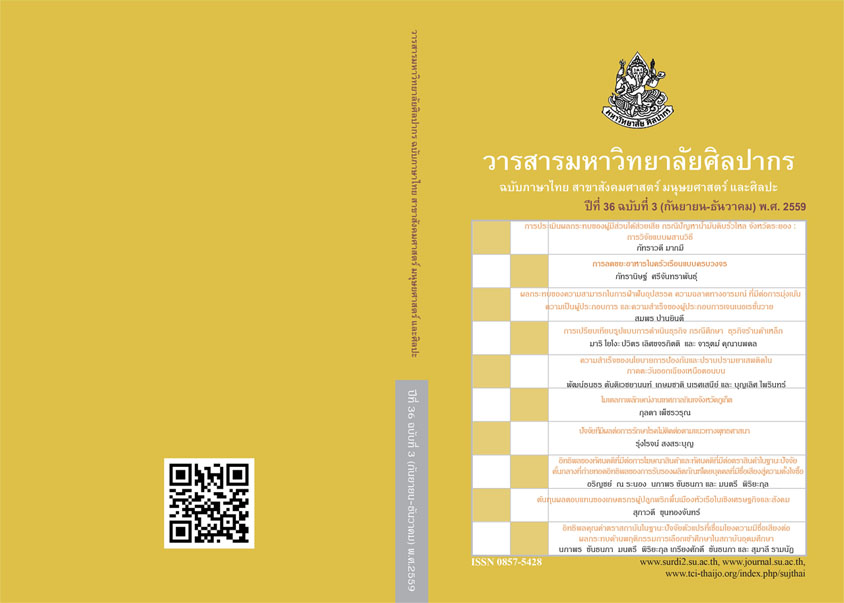การลดขยะอาหารในครัวเรือนแบบครบวงจร (Integrated Food Waste Reduction in Households)
Main Article Content
Abstract
ที่ผ่านมาประเทศไทยไม่มีการรณรงค์ลดการสูญเสียอาหารในครัวเรือนก่อนที่จะเป็นขยะอย่างจริงจัง ทำให้ปริมาณขยะอาหารกลับมีแนวโน้มสูงขึ้น อันเนื่องจากสังคมขาดความรู้ ความเข้าใจในขั้นตอนที่ทำให้เกิดขยะอาหารในครัวเรือน จึงเป็นเหตุให้คนทิ้งขว้างอาหารซึ่งเป็นสาเหตุสำคัญของการอาหารทั้งที่ยังไม่ได้บริโภคและทิ้งโดยไม่ตั้งใจ บทความนี้มีวัตถุประสงค์เพื่อนำเสนอมโนทัศน์และแบบจำลองของการลดขยะอาหารในครัวเรือนแบบครบวงจร โดยรูปแบบการนำเสนอจะใช้วิธีการทบทวนวรรณกรรม การวิเคราะห์เอกสาร และนำเสนอรายงานแบบพรรณนาเชิงวิเคราะห์ ผลการศึกษาพบว่า กระบวนทัศน์ใหม่ในมุมมองของการลดการเกิดขยะอาหารในครัวเรือนแบบครบวงจร จะยึดหลักการจัดการก่อนจะเป็นขยะอาหาร และมุ่งเน้นที่การจัดการภายในครัวเรือนที่ใช้งบประมาณน้อย ลดค่าใช้จ่ายในการจัดการขยะโดยรวมและลดผลกระทบสิ่งแวดล้อม อีกทั้งจุดประกายความสนใจและรณรงค์สร้างความตระหนักให้กับชุมชนเพื่อนำไปสู่การปรับเปลี่ยนพฤติกรรมที่ทุกครัวเรือนสามารถปฏิบัติได้ในการลดการทิ้งขว้างอาหาร
Downloads
Article Details
References
Corrado, M. (2007). Understanding Consumer Food Management Behaviour. WRAP Report. [Online]. Retrieved January 8, 2015 from https://www.wrap.org.uk/downloads/Understanding_consumer_ food_management_behaviour_jly_2007.0480a34c.6395.pdf.
Cox, J and Downing, P. (2007). Food Behaviour Consumer Research: Quantitative Phase. WRAP Report. [Online]. Retrieved January 11, 2015 from https://www.wrap.org.uk/ content/food-behaviour-consumer-research-quantitative-phase.
EPRS. (2014). Tackling Food Waste: the EU’s Contribution to a Global Issue. [Online]. Retrieved February 24, 2015 from https://www.europarl.europa.eu/RegData/bibliotheque/briefing/ 2014/130678/LDM_BRI (2014)130678_REV1_EN.pdf.
European Commission. (2010). Preparation Study on Food Waste across EU 27. France: BIO Intelligence Service.
FAO. (1981). Food Loss Prevention in Perishable Crops. Agriculture Services bulletin No. 43, Rome: FAO.
Glanz, R. (2008). Causes of Food Waste Generation in Households – An Empirical Analysis M.Sc. Thesis. University of Natural Resources and Applied Life Sciences, Vienna and Cranfield.
Grethe, H., Dembélé, A. and Duman, N. (2011). How to feed the world’s growing billions. Understanding FAO world food projections and their implications. Germany: Heinrich Böll Stiftung und WWF Deutschland.
Gustavsson, J., Cederberg, C., Sonesson, U., van Otterdijk, R. and Meybeck, A. (2011). Global Food Losses and Food Waste: Extent, Causes and Prevention. Rome: Food and Agriculture Organization of the United Nations.
Hall, K., Guo, J., Dore, M. and Chow, C. (2009). The Progressive Increase of Food waste in America and Its Environmental Impact. PLoS ONE, 4(11): 1-6.
Hamilton, C., Denniss, R. and Baker, D. (2005). Wasteful Consumption in Australia. Discussion Paper Number 77. Canberra: The Australia Institute.
Hodges, R. J., Buzby, J. C. and Bennett, B. (2011). Postharvest losses and waste in developed and less developed countries: opportunities to improve resource use. The Journal of Agricultural Science 149: 37–45.
Institution of Mechanical Engineers (ImechE). (2013). Global Food: Waste Not, Want Not. London: Institution of Mechanical Engineers.
Johnson, D., Hipps, N. and Hails, S. (2008). Helping Consumers Reduce Fruit and Vegetable Waste: Final Report. UK: WRAP.
Lee, P. and Willis, P. (2010). Waste Arisings in the Supply of Food and Drink to UK Households. WRAP project code SC002-005. [Online]. Retrieve January 11, 2015 from https://www.wrap.org.uk/content/waste-arisings-supply-food-and-drink-uk-households.
Parfitt, J., Barthel, M. and Macnaughton, S. (2010). Food Waste within Food Supply Chains: Quantification and Potential for Change to 2050. Philosophical Transactions of the Royal Society B: Biological Sciences, 365(1554): 3065–3081.Priefer, C., Jörissen, J. and Bräutigam, K. (2013). Technology Options for Feeding 10 Billion People: Options for Cutting Food Waste. Brussels: the European Parliament Science and Technology Options Assessment.
Quested, T. E., Marsh, E., Stunell, D. and Parry, A. D. (2013). Spaghetti Soup: The Complex World of Food Waste Behaviour. Resources, Conservation and Recycling, 79: 43–51.
Schneider, F. (2008). Wasting Food - An Insistent Behaviour. [Online]. Retrieved January 29, 2015 from https://www.ifr.ac.uk/waste/Reports/Wasting%20Food%20-%20An%20Insistent.pdf.
Sharp, A. and Sang-Arun, J. (2012). A Guide for Sustainable Urban Organic Waste Management in Thailand: Combining Food, Energy, and Climate Co-Benefits. Japan: Institute for Global Environmental Strategies.
Sinsuwan, P. (2014). Municipal Solid Waste: the Significant Problem of Thailand (ขยะมูลฝอยชุมชน ปัญหาใหญ่ที่ประเทศกำลังเผชิญ). [Online]. Retrieved January 9, 2014 from https://library.senate.go.th/document/Ext7449/7449113_0002.PDF
The Government Office of Science. (2011). The Future of Food and Farming: Challenges and choices for global sustainability. London: The Government Office of Science.
UN News Center. (2012). Nearly 870 million people chronically undernourished. [Online]. Retrieved February 24, 2015 from https://www.un.org/apps/news/story.asp?NewsID= 43235#.VPFw4nysV4s
UNESCO. (2009). Water in a Changing World. [Online]. Retrieved February 9, 2015 from https://webworld.unesco.org/water/wwap/wwdr/wwdr3/pdf/WWDR3_Water_in_a_Changing_World.pdf.
United States Environmental Protection Agency. (2012). Food: Too Good to Waste Pilot. USA: United States Environmental Protection Agency
.Ventour, L. (2008). The food we waste (Food waste report V2). [Online]. Retrieved February 4, 2015 from https://www.ifr.ac.uk/waste/Reports/WRAP%20The%20Food%20We%20 Waste.pdf.
WRAP. (2007). Understanding Food Waste. [Online]. Retrieved February 23, 2015 from https://www.wrap.org.uk/retail/case_studies_research/report_the_food_we.html.


